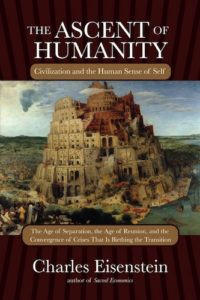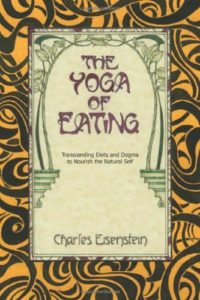Climate — A New Story
Chapters
Chapter 8: Regeneration
Why Is Regenerative Agriculture Marginal?
Whether from the carbon frame, the water frame, or the biodiversity frame, regenerative agriculture makes ecological sense. It also makes sense from the point of view of food productivity. Why then, despite rising popularity, does it remain so marginal—agriculturally as well as scientifically?
The reason has to do with its incompatibility with ingrained ways of thinking, economic institutions, and scientific practices.
Farms such as Brown’s and Gotsch’s use a dynamic combination of many regenerative practices that are sensitive to unique and ever-changing local conditions. This makes it very difficult to isolate and quantify the effects of any single practice. A scientific demonstration of any of those practices would entail holding other variables constant across multiple test fields and control fields. This is not how regenerative agriculture works. One cannot apply standard processes to multiple parcels of land, because each place is unique. Therefore regenerative practices do not fit easily into current scientific protocol.[11] Furthermore, the pesticide, fertilizer, and genetically modified seed companies that fund most agricultural research have little incentive to fund studies of practices that require none of the above. Therefore, the data on the carbon sequestration, water retention, biodiversity benefits, and so on for regenerative agriculture remains mostly anecdotal.
The lack of hard data, in turn, prevents regenerative agriculture from entering a data-driven policy discourse. When environmental policy is based on quantitative greenhouse gas targets, how does one promote practices that do not easily generate quantifiable results? Compared to fossil fuel emissions, underground biotic carbon storage is hard to measure even when we attempt it. Harder still to quantify would be the indirect benefits of biodiversity, groundwater recharge, and so forth.
It is not that policymakers find Gotsch’s achievements unimpressive (his short film was shown at COP21). It is that they are hard to translate into current data-based policy. Ultimately we are being invited into a different way of engaging the world. Only dead things can be reduced to a set of data. A civilization that sees the world as alive will learn to bring other kinds of information into its choices.
Regenerative agriculture represents more than a shift of practices. It is also a shift in paradigm and in our basic relationship to nature.
Regenerative agriculture seeks to mimic and participate in nature, not dominate it. In the holistic view of regenerative agriculture, problems like low fertility, runoff, weeds, and pests are understood as symptoms of a disharmony between the farmer and the land. Instead of going to war against the problems, the farmer seeks to adjust her practices to restore soil health, water health, species distribution, and so on, in a process of deepening relationship.
In many respects, regenerative practices like organic no-till horticulture and management-intensive grazing fit poorly into the present agricultural-industrial complex, which favors standard products via standard processes with standard inputs at a predictable cost. Regenerative practices require intimate knowledge of the micro-conditions of each place. What works in Austria may not work in Cameroon, or even in the next valley over. What worked last year may not work this year.
There is no formula that says how long a herd should stay in each paddock for maximum soil regeneration. The farmer has to observe conditions and consider them in light of past learning, his own and possibly that of his father, his grandfather, his neighbors … learning through trial and error and adding to the knowledge base. Likewise, there is no formula that says how deep to dig a swale and what to plant in it for best water retention. There is no formula for which cover crop mix is best. All of these are context-dependent. That means a farmer can never be a mere laborer.
For a regenerative agriculture system to work, farmers need to relate to land as to a unique individual. They must learn to listen to, see, and feel its needs and moods. Allan Savory goes without shoes to pick up subliminal information about the land he walks. The knowledge of a place builds over a lifetime and over generations, becoming embedded in a local culture. This kind of relationship is totally different from that of industrial agriculture, which treats parcels of land as just so many standard units, describable in terms of quantities of nitrogen, phosphorus, potassium, rainfall, pH, and so forth. Regenerative agriculture rejects the industrial model of production, with its pursuit of standardization and scale.
A food system that starts with intimate relationship to land will occupy a different place in society from the current system. For one thing, it requires a lot more time, and therefore a much larger segment of the population to practice farming and gardening.
At present, less than 1 percent of the population of the United States makes their living farming, down from two-thirds in 1850, half in 1880, and 10 percent as recently as 1955. Even in absolute terms, the farm population has fallen by 90 percent from its peak of about 32 million in 1910.[12] Other countries have showed a similar trend. Demographers and climate thinkers usually take its continuation for granted: one frequently reads statements like “By 2050, 70 percent of the world’s population will live in cities.”
This is a trend that must change if we are to live in right relationship to Earth. Urbanization is not some law of nature, nor an inevitable stage of human progress. Economic and technological conditions, among them the mechanization of agriculture and its conversion into commodity production, drive urbanization. Urbanization is uprooting; it is disconnection from the places of multigenerational cultural embedment; it is a distancing from the land. Yes, there is a role for cities; the archetype of the city will not and should not disappear from earth. Cities can be beautiful cauldrons of cultural ferment, alchemic crucibles that yield products only possible in an intense concentration of humanity. Yet for many, the land is calling; in fact, the trend toward urbanization is already showing signs of reversing in some developed countries. According to the 2014 USDA census, the number of young farmers began growing in 2007, reversing a longtime trend.
An objection to the call for more people involved in farming goes like this: “That’s easy for you to say, because you are a privileged professional who doesn’t know how hard and laborious farm work is.” This objection fails on several fronts, not the least of which is that I do spend a lot of time doing manual labor on my brother’s farm. Farm work in the context of industrial agriculture is very different from farm work on small, diverse, ecological farms. On the latter, tasks are diverse as well; rarely does one spend hour after hour, day after day, picking beans or driving a tractor back and forth. On the industrial farm, work is much like any industrial work: repetitive, routine, and dehumanizing. No wonder its final stage is its literal dehumanization, in the sense of replacing people with machines. The techno-utopian dream of transcending labor seems quite attractive if we take for granted what labor became with the rise of technology.
In the Story of Ascent, a move back to the land would be a regression. We were supposed to be progressing away from labor, away from materiality, away from the dirt. In that story, heavenly was better than earthly, high better than low, clean better than dirty, the mind better than the body, and the highest social classes the ones furthest removed from the land. Today’s new computerized robotic hydroponic vegetable factories are its inevitable outgrowth. You can see how big a change it is to revere the farm again, and to reunite with the long-distanced material world.
Projections of growing urbanization take for granted the very thing that must change.
End Notes
[11] The same point applies to holistic medicine. Because each body is unique, true holistic medicine is resistant to validation through controlling variables across standard diagnostic and therapeutic categories.
12 Spielmaker (2018).






